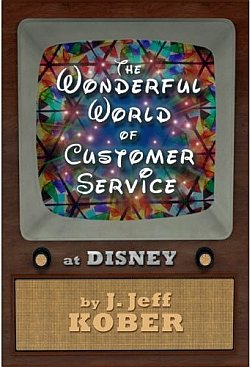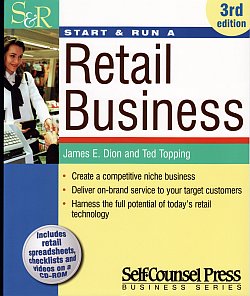FROM: Perfecting the Customer Experience A Disney Dispatch Feature
Day Two: Disney's Service Values
In the second of three articles about the Disney customer experience, Ted Topping explains Disney's service values (safety, courtesy, show, efficiency) and, in the clever context of a ride on Mickey's Fun Wheel, demonstrates their use.
In many organizations, small groups of strategic thinkers get together and, over time, develop a vision ("Our organization will be...") and a mission ("Our organization will do...").
The process is far more difficult than it appears to be from the outside, and it typically requires people to make some tough choices based on inevitably conflicting values.
But once the vision and mission are complete, the process too often ends there. Things stop just as the entire effort could have become useful.
By this, we mean taking the next step and translating the vision and mission into things that management and staff can actually use: service standards and service values.
- Service standards are typically used to communicate your brand to external customers.
- Service values are typically used to communicate your service culture to internal customers (your employees).
Disney's Four Service Standards
Disney has four service standards and values: safety, courtesy, show, and efficiency. Learning about them and starting to understand them through firsthand experience are highlights of our Perfecting the Customer Experience program.
Jeff Kober and I start from the understanding that customers experience retail and other service environments with all of their senses (sight, sound, smell, touch, and taste). It is a total experience that we all inevitably have.
But asking a program participant to monitor all of their senses in the overload of a theme park would probably be asking too much.
click an image to expand:
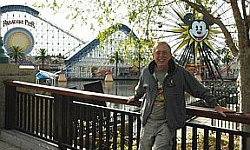
Ted Topping with Paradise Pier and Mickey's Fun Wheel in the Background
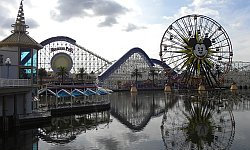
Paradise Pier and Mickey's Fun Wheel
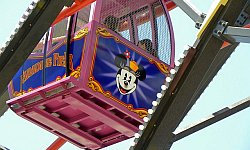
Close-up of a Gondola on Mickey's Fun Wheel
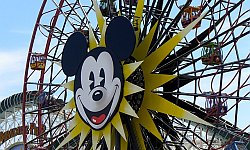
Mickey's Fun Wheel has Eight Traditional Gondolas Fixed on the Outer Rim and 16 Free-mounted Gondolas, Each of Which Rolls on Its Own Oval-shaped Rail.
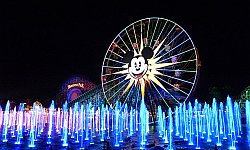
The World of Color Illuminates the Night
This is why we explain that service standards and values provide a framework for behavior in the workplace. That they are empowering tools that enable people to take action in the moment. And that they should be applied consistently across all functions in the organization.
In the case of Disney, service standards and values are easy to observe once you know what you are looking for.
- Safety is always the first priority. This is a matter of guests knowing and sensing at every level that they can trust themselves to Disney in what may appear to be a threatening situation (for example, The Twilight Zone Tower of Terror).
- Courtesy is always the second priority. And if you believe that reflecting basic standards of etiquette is a no-brainer in business, consider how complicated things can get when guests come from culturally diverse backgrounds.
- Show is always the third priority. This is Disney, after all. People from around the world feel that they understand the Disney brand, and they have exceptionally high expectations about everything when they visit one of the theme parks.
- Efficiency is always the fourth priority. In most situations, this is a matter of moving as many guests as possible through an attraction or experience in a given period - reducing the time that guests spend in a queue as a bonus.
The real power of these standards and values is that they help Disney Cast Members at every level know precisely what choice to make when they face a decision. The Cast Members simply need to base their decision on the highest relevant standard or value on the list.
An equivalent list would do the same for any organization. This is not a matter of having a big budget, it is a matter of thinking clearly, knowing exactly what kind of customer experience you want to provide, and then empowering people to execute on those values.
In Perfecting the Customer Experience, we build everything we do around the way that adults learn: through personal discovery and by doing. This is what makes the Disneyland program so powerful. Simply reading or watching videos provides knowledge, but most of that never results in people actually doing something differently. Learning through personal discovery does.
The Lesson of Mickey's Fun Wheel
As an illustration, let's consider a visit to Mickey's Fun Wheel, one of the most popular attractions in Disney's California Adventure Park.
There is an incredible amount of fascinating - and somewhat distracting - construction taking place in that area right now, but Mickey's Fun Wheel remains a great place to experience what we have learned about service standards and values.
- As we approach the attraction, we start to become aware of the area music that surrounds us. It is appropriate to our Paradise Pier surroundings, and it is neither loud nor overbearing (show).
- Next we notice a greeter at the attraction entrance. This Cast Member greets us (courtesy), answers any questions we have about the attraction, and handles individual needs such as mobility challenges (safety, courtesy, efficiency). He also identifies guests who may not meet certain ride requirements before they line up (safety, efficiency). That seems like a huge amount for one person to be doing - much more than the word 'greeter' would suggest.
- We then must decide which of the two queues to join. The line on the right will take us to a so-called free-mounted gondola; the one on the left will take us to a so-called traditional gondola. For anyone prone to motion sickness, or young children who may be overwhelmed by an extended, uncontrollable experience, the traditional gondola is the better choice (safety, courtesy, show, efficiency). We chose that as well.
- As we progressed through the queue, we noticed that the Cast Members loaded three gondolas at a time. And that four Cast Members had to indicate through a hand signal that their station was clear before the wheel cycled to the next set of three gondolas (safety).
- When it came our turn to board, the costumed Cast Member asked how many people were in our party, and she then held open a safety gate so that we could enter the gondola. She asked us not to move around the gondola or to change seats once the ride started (courtesy, safety, show, efficiency). We promised to behave.
- After we were in the gondola, we noted the rubber stripping on the doors that would prevent injury if the doors unexpectedly closed while we were boarding, and the wire mesh on the gondola openings that both would keep us safe and prevent misfortunes such as our camera falling out during the ride (safety, courtesy).
- Once we were 150 feet in the air, however, we forgot to look for service standards and values, and simply enjoyed the ride experience for nine exhilarating minutes.
This is exactly what guests should be able to do in any retail or other service environment, and Disney knows how to do it consistently and for literally millions of guests each year.
It's why they remain an excellent company to benchmark and learn from.
For more information about Perfecting the Customer Experience, please contact Jeff Kober or Ted Topping. The next public programs are September 27 to 29, 2011 and February 21 to 23, 2012. Companies may prefer a private, tailored experience. Neither the program nor its facilitators are associated in any way with The Walt Disney Company.






